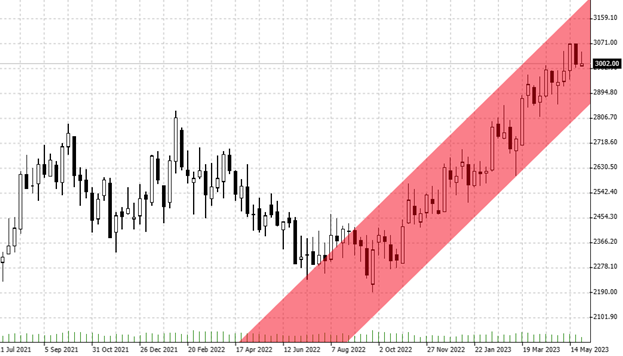

06.06.2023 – Chocolate lovers must now be very strong: The prospects of rising prices have once again strengthened. We provide a brief update on this interesting traders market.
You rarely see such a stable chart tunnel: Cocoa is working its way inexorably upwards, here is the weekly view. There has been a lot of news in the past weeks – most of them bullish.

Last Wednesday, for example, the International Cocoa Organization (ICCO) released its Quarterly Bulletin of Cocoa Statistics. According to the report, output in the current 2021/22 season will fall 6 percent to about 4.9 billion metric tons. At the same time, the volume processed at mills will increase by 2 percent to 5.05 billion metric tons, it said. The gap would be filled by inventories, which are expected to fall by about 9 percent, he said.
Bullish news from the ICCO
The organization cited bad weather and disease as reasons for the falling crop. We add: Farmers are plagued by what is known as Cocoa Swollen Shoot Virus Disease (CSSVD). In addition, a fertilizer shortage in the wake of sanctions against Russia will reduce supply, according to the ICCO. Demand is picking up in part because airports have reopened after Corona, he said – where a lot of chocolate is sold. The ICCO includes 22 exporting countries and 21 importers.
Nigeria and Ivory Coast supply less
According to the Barchart.com website, the Cocoa Association of Nigeria reported in late April that exports were down 42 percent month-over-month and 34 percent year-over-year in April. Nigeria is the world’s number five producer.
Also, Côte d’Ivoire reported a decline of minus 4.6 percent year-on-year in the commodity sent to ports by farmers, “Barchart.com” explained. Most notably, Ivory Coast’s Ministry of Agriculture said that the mid-crop, which is the smaller crop that began in April, will likely fall 25 percent year over year to 450,000 tons.
Bearishe news was rather scarce. In mid-May, news hit the market that inventories in U.S. commodity warehouses, as counted by ICE, had risen to a seven-and-a-half-month high. In Europe, too, warehouses were fuller than they had been in nearly eight months.
Rising demand
Meanwhile, demand continues to pick up: At the end of April, the National Confectioners Association had reported a 2.4 percent month-over-month increase in processing for the first quarter in North America – with the year-over-year figure showing a 4.4 percent drop. However, the Cocoa Association of Asia reported a 4.1 percent year-over-year increase in processing. By mid-April, the European Cocoa Association had already reported a 0.5 percent year-over-year increase in mills for the first quarter. That doesn’t sound like much, but Europe reported the strongest first quarter consumption since 1999.
The conclusion from all this is that there is currently a lot to be said for the continuation of a bull market. Whether long or short – Bernstein Bank wishes successful trades and investments!
__________________________________________________________________________________________________________________
The content of this publication is for general information purposes only. In this context, it is neither an individual investment recommendation or advice nor an offer to purchase or sell securities or other financial products. The content in question and all the information contained therein do not in any way replace individual investor- or investment-oriented advice. No reliable forecast or indication for the future is possible with respect to any presentation or information on the present or past performance of the relevant underlying assets. All information and data presented in this publication are based on reliable sources. However, Bernstein Bank does not guarantee that the information and data contained in this publication is up-to-date, correct and complete. Securities traded on the financial markets are subject to price fluctuations. A contract for difference (CFD) is also a financial instrument with leverage effect. Against this backdrop, CFD trading involves a high risk up to the point of total loss and may not be suitable for all investors. Therefore, make sure that you have fully understood all the correlating risks. If necessary, ask for independent advice. CFDs are complex instruments and are associated with the high risk of losing money quickly because of the leverage effect. 68% of retail investor accounts lose money trading CFD with this provider. You should consider whether you understand how CFD work and whether you can afford to take the high risk of losing your money.7
